by Elizabeth Cunningham
Now in its third month, the Mabel Dodge Luhan & Company exhibition lives up to “a tour de force of epic proportions.” The show takes up most of the Harwood Museum of Art with its 140 art pieces and over 40 literary works and material culture objects.
With a background in art of the Southwest, I have considerable expertise. Imagine my pleasure at making new discoveries. Taos, New Mexico, a photo by renowned French photographer Henri Cartier-Bresson, who spent one day here in 1947. Three small photos by Dorothea Lange shot in 1931, foreshadowing her epic Dust Bowl series.
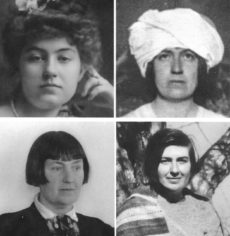
Portraits of Mabel in Buffalo, Florence, New York and Taos. Mabel Dodge Luhan Papers, Beinecke Rare Book and Manuscript Library, Yale University
Interesting to me is the use of Mabel’s life story as entree to interpreting the art works in the exhibition. In a 1914 letter to Alfred Stieglitz, modernist artist Marsden Hartley hints at this woman’s many facets:
Mabel Dodge is really the most remarkable woman I ever knew. … She is so intelligent and so sympathetic and like yourself a real creator of creators.
Lois Rudnick once wrote that Mabel, “an artist of life,” constructed many selves. In her introduction to the Mabel Dodge Luhan & Company: American Moderns and the West book, art historian Wanda Corn delineates Mabel’s several selves on her route “to find her modern place in history.” Among them she lists Mabel the liberated “New Woman” who married without her parents’ permission and later promoted free love.
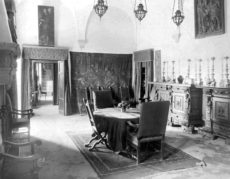
Dining Room, Villa Curonia, Florence, Italy. Mabel Dodge Luhan Papers, Beinecke Rare Book and Manuscript Library, Yale University
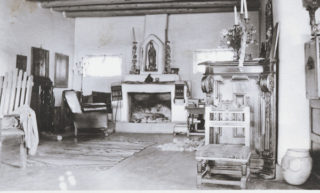
Living room, Big House, Taos, New Mexico. Mabel Dodge Luhan Papers, Beinecke Rare Book and Manuscript Library, Yale University
Interior designer Mabel created three separate homes in Florence, New York, and Taos. John Collier, Jr. who spent time over the years visiting Mabel in Taos with his family, considered her houses “an extension of her interior design.” She combined French and Italian chairs and sofas, bedecked with colorful pillows, with American-made oak and pine trestle tables, straw-seated Mexican chairs, Navajo rugs, and French silk wall hangings. Indian weavings and santos decorated the mantelpieces.
Philanthropist and publicist Mabel helped open the way for the avant-garde. In 1911 Mabel saw Gertrude and Leo Stein’s collection of modern art by Picasso, Matisse, Cezanne, and several others in Paris. Impressed by this new art, Mabel leaped at the opportunity to help promote the New York Armory show. She raised and contributed funds and procured loans of paintings in private collections. The all-male board named Mabel one of two women honorary vice presidents in recognition of her efforts.

The Armory Show, officially known as The International Exhibition of Modern Art, opened on February 17, 1913. Over 1200 works of modern art — paintings, sculptures, and decorative works – represented more than 300 European and American artists. Shock and outrage were predominant reactions to the new art. Yet some, like Mabel, embraced its possibilities. She contributed and interpreted the only non-visual work of art in the show: Gertrude Stein’s cubist word picture Portrait of Mabel Dodge at the Villa Curonia. With that Mabel not only introduced Gertrude to American audiences, she also won notoriety for herself. She wrote “if Gertrude Stein was born at the Armory Show, so was ‘Mabel Dodge’.”
Mabel the art connoisseur collected paintings by modernists Andrew Dasburg, Marsden Hartley and Max Weber. And Mabel the art promoter, assembled works by Pueblo easel painters and a collection of eighty-five historic northern New Mexican santos (images of saints), then premiered them in separate New York exhibitions in the early 1920s.
As a salonniere, Mabel hosted leaders of first generation American radicals. These included birth controlist Margaret Sanger, anarchist Emma Goldman, journalists Lincoln Steffens and John Reed, and modern artists Marsden Hartley and Andrew Dasburg. Deemed the most significant salon in 20th-century American history, Mabel created “the one place in American life that truly tested the limits of modernism” (Robert Grunden in American Salons).
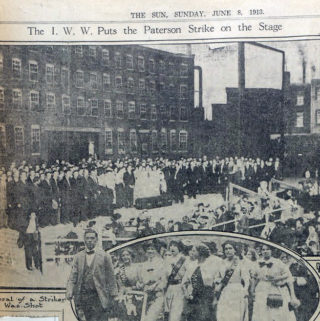
Paterson Strike Pageant, New York Sun, June 8, 1913. Mabel Dodge Luhan Papers, Beinecke Rare Book and Manuscript Library, Yale University
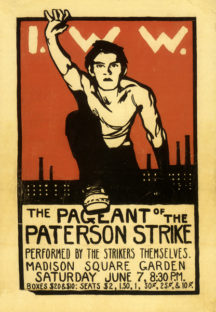
Robert Edmond Jones, The Pageant of the Paterson Strike, Madison Square Garden, NY, June 7, 1913, program cover. Taminent Library and Robert F. Wagner Labor Archives, New York University
The Paterson Strike Pageant was one of Mabel’s first undertakings as an activist. Bill Haywood, leader of the Industrial Workers Union, spoke about the plight of striking silk workers in Paterson, New Jersey. He was looking for a way to help the strikers by showing the oppression and police brutality they suffered. Mabel suggested bringing the strike to New York and “show it to the workers.” Weeks later anarchists and socialists united with painters and poets to produce the Paterson Strike Pageant. On June 12, 1913 over 1000 Paterson workers themselves reenacted scenes from the strike: the closed mills, the gunmen, the murder of the striker Valentino Modesto and his funeral. The great strike pageant packed Madison Square Garden. Mabel got credit for the idea, deemed “the act of an imaginative press agent of a high order.”
Until her departure for New Mexico in 1917, Mabel wrote for such leading modernist literary and art magazines as The Dial and Alfred Stieglitz’s Camera Work, the leftist journal The International, and the radical magazine The Masses. For a brief time Mabel worked as a syndicated columnist for the New York Journal. In Taos she authored the four-volume Intimate Memories (1933-1937), Winter in Taos (1935), Lorenzo in Taos (1932), and Taos and Its Artists (1947). [All of these books included in the Mabel & Company exhibition.]
In her role as arts patron in Taos, Mabel offered a place for her visitors to learn, experience, and create within the context of the rich and diverse peoples, culture, and history of northern New Mexico. In 1919 Mabel wrote Mary Austin about her wish to have her home serve as a “creative center—not just a place for people to retreat into.” Actualizing this desire by providing lodging, meals and transportation, Mabel can be said to have created the first artist residency in New Mexico.
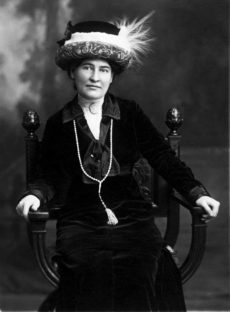
Willa Cather, circa 1912, wearing necklace from Sarah Orne Jewett. Wikipedia Commons
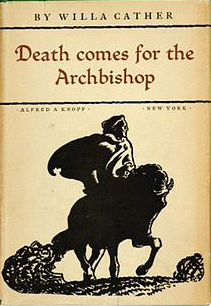
Cover of Death Comes for the Archbishop. New York : A.A. Knopf, 1927. First edition.
Willa Cather stayed at Mabel’s in 1925 and 1926, working to complete her novel, Death Comes to the Archbishop. Her companion Edith Lewis summarized what Mabel’s support meant to her guests.
[Mabel was] essentially an artist herself—knew the conditions that contribute to an artist’s work, and was able to create them. She had, too, a large ungrudging generosity toward people she admired; one felt that she enjoyed helping them toward their aim and seeing them realize their desires.
Until the advent of Mabel Dodge Luhan & Company, Lois Rudnick believed Mabel’s work had been undervalued. The exhibition and accompanying book prove her to be, as Wanda Corn states, “an influential figure in transatlantic Modernism…a participant and generator and catalyst in the circles where men and women shed their 19th-century identities and invented new ones befitting what they deemed to be an unprecedented modern era.”
….
In the months that follow, I will focus on the treasures and themes inherent in Mabel & Company show. My intent is to make the exhibition come alive for our readers.
Next in the Mabel Dodge Luhan & Company series: Mabel’s beginnings, Buffalo, New York, 1879-1912
Select sources:
Mabel Dodge Luhan & Company: American Moderns and the West. Edited by Lois P. Rudnick and MaLin Wilson-Powell, 2016; Intimate Memories: The Autobiography of Mabel Dodge Luhan. Edited by Lois Palken Rudnick, 1999; Utopian Vistas: The Mabel Dodge Luhan House and the American Counterculture by Lois Palken Rudnick, 1996; Mabel Dodge Luhan: New Woman, New Worlds by Lois Palken Rudnick, 1984.